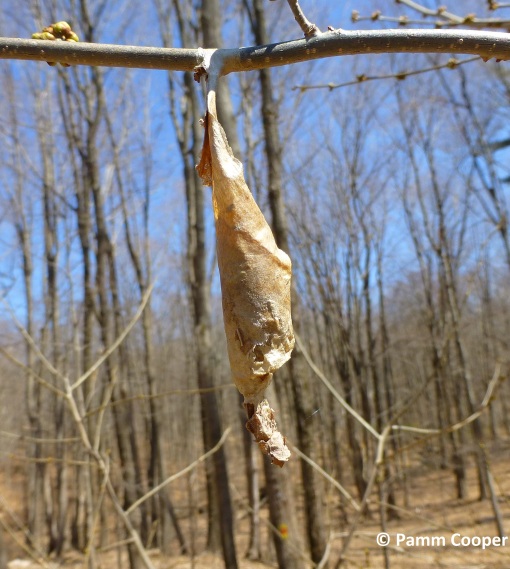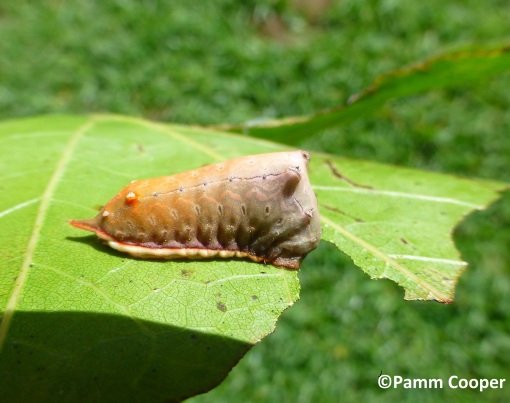Thus hath the candle singed the moth.
-William Shakespeare
Anyone who has lived in New England and been around outdoor lights in May or June may have encountered some of our giant silkworm moths which .are members of the Saturniidae moths. The diminutive slug moths, Limacodiae, are perhaps not as well known, but they are commonly attracted to lights as well. Both are natives here in Connecticut and are spectacular in their own way.
The Cecropia moth and its caterpillar are likely the champs, the Goliaths of their peers. The moth may be as large as a man’s hand, and the caterpillar comes close to the same size, at least in length. Late instar caterpillars can be heavy enough to cause small branches to droop. Caterpillars feed on locally preferred plants, especially cherry, ash and apple, but also other woody plants. Cocoons are made of leaves tied tightly together lengthwise along twigs or small branches, where they may remain all winter. Pupation takes place inside this structure.
Luna moths are probably the most recognized giant silkworm moth with their light green color and a pair of long tails streaming from the hind wings. Polyphemus are another species that have beautiful blue and yellow eye spots on the hind wings. Late instar Polyphemus caterpillars have striking white dots along their body that shimmer with silver at certain angles in bright sunlight.
Promethea moths have a strong preference for spicebush, sassafras and cherry for caterpillar host plants. Along with Io moths, their caterpillars follow each other in the very early instars, forming a train-like procession as they travel over a leaf. Both species also feed together for much of their life as a caterpillar.
All silkworm moths lack fully developed mouths and cannot feed. They mate soon after emerging from their cocoons, as their life span as a moth is short. All overwinter as pupa and most emerge mid- May and onward the following year. Eggs are large and smooth. Somewhat flattened, and may be laid singly or in small to large rafts, depending upon species.
On the opposite side of the spectrum as far as size goes are the slug moths and their caterpillars which may be only one centimeter in size. Often found in late summer or early fall, the caterpillars often resemble galls or something else of uncaterpillar-like. They have medial suckers instead of legs and they glide along like slugs.
Always be careful not to touch caterpillars of the slug moth as many have spines that can inflict a painful sting that feels like being stabbed with dozens of hot hypodermic needles. One of the worst stings is from the aptly named saddleback, which has both its rear and tail ends covered with stinging spines. This year, green briar was a preferred host in the north central part of Connecticut, but they can be found on a variety of other plants including oaks, cherry, blueberry and sometimes herbaceous perennials.
Slug moths are attracted to lights, and if identified, a search of larval host plants nearby may yield some caterpillars. Feeding takes place along leaf edges, and sometimes a shiny trail is left where they have glided along the leaf. Adult sightings peak in midsummer, with caterpillars found from June- October. Like the giant silkworms, adult slug moths do not eat.
The smaller parasa reminds me of a Shar-Pei. They have retractable spines, but they are mostly hidden inside warts along the back. When threatened, spines protrude in small clusters from the warts. I have found these most often on oaks, but they will feed on other woody plants also.
Skiff moth caterpillars have steep sides and have a short, sharp tail on the rear. Various brown markings help them blend in with dead plant tissue, so they may be hard to find. This slug cat is often found on the upper sides on leaves, though, rather than the undersides where other slug caterpillars are found. Moths can be found early in the night around outdoor lights near woods.
Next year, be on the alert for our native slug moths and giant silkworm moths. Check around outdoor lights in May- June for the moths, and look on specific host plants for the different species of these interesting caterpillars. The excitement never ends…
Pamm Cooper
















December 13, 2019 at 10:13 pm
Great pictures! Sadly the moths that seem to come to my lights at night are boring all-brown or all-white ones, nothing so colorful. I was surprised to see a brown one Monday night (12/9). Granted it was 50 degrees, but I was surprised any of them could have survived the sub-20 degree nights.